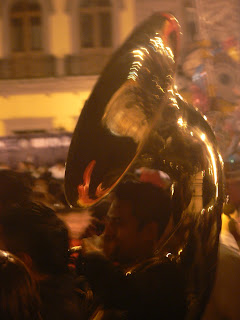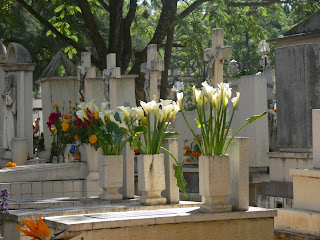
After quite a few aborted attempts - there always seemed to be maintenance, or a wedding, or some other thing that closed the place down - we finally managed to visit the inside of the ethno-botanical garden in downtown Oaxaca. Thanks to the recommendation of our landlord, we timed this visit to coincide with the start of a tour that explained many of the plants and their place in history, folk-medicine, etc. (The tour is made even more useful by the fact that there are no placards or labels anywhere in the garden. The rumor we heard was that the a key artist-benefactor of the garden is emphatically opposed to such distractions.)
Even aside from the plants, the history of the garden is interesting in and of itself. Originally, the land was used by the monks of Santo Domingo to grow food for themselves and the surrounding area. There are various remnants of their presence still (aside, of course, from the enormous monastery and cathedral), including the original irrigation troughs (the flowers are new) . . .
. . . and the laundry/baths. The tile-lined basin is the foot-bath. (The tiles aren't original, but have been reconstructed based on evidence from other sites. The army filled in much of this area with dirt and garbage, much to its detriment.)
Still standing as well are the giant limestone ovens (behind the nameless spiny plants below) which were essential to pre-industrial construction. Roaring fires were stoked in enormous brick-lined pits, to which blocks of limestone were added. Once the limestone were hot enough, gates to adjacent reservoirs were opened, allowing cool water to flood into the oven pits. The water caused the hot limestone to explode (reportedly, with sometimes dangerous effects) after which the powder could be collected to serve as binder/mortar for stone buildings.

In the early 1900s, because the monks had gradually abandoned the monastery for other parts of Mexico, the Mexican army took control of the complex, converting it to a general barracks, firing range, prison, and soccer field. But, when most of the soldiers were transferred to the state of Chiapas in 1993 due to serious unrest there, the site reverted to the city of Oaxaca. Originally, the plan was to sell the land to American developers, who would have converted the space into Oaxaca's most expensive hotel, complete with a shopping mall and enormous parking lot. Fortunately for everyone, however, a coalition of influential Oaxacan artists gathered sufficient political support to block the sale and turn the land, instead, into a beautiful museum and botanical garden.
As an aside, one artist in particular - Francisco Toledo - has been instrumental in a number of other distinctive improvements of the city. For example, his hunger strike prevented the city from cutting down the majestic trees in the Zocalo and thus, thankfully, saved the shade there for everyone. And when MacDonald's planned to put up a restaurant there, complete with towering golden arches, his protest, complete with free tamales for all comers, pushed the company to relocate far to the edge of town. One of his sculptures graces the new entryway. It's carved from a sycamore of the same type as the Tule tree, which had become diseased and had to be cut down, the coated in mica and wax.

In the picture below you can (just) see that the water flowing over the sculpture has been dyed with red dye from the cactus parasite, cochineal. This is the same parasite that the weavers at Teotitlan del Valle still use to color their yarn. When the conquistadors arrived, they quickly identified the cochineal as a valuable export, because, until that point, Europe lacked a permanent red dye - beet juice was commonly available, but faded with washing. In fact, this is why nopal cactus are found in Old World areas, despite originating in America - they were transplanted by the Europeans to facilitate easier harvesting of the parasite. The water in the sculpture has been dyed to represent the cost in blood and lives of the Europeans search for wealth in the Americas.

The garden itself is set up with zig-zagging paths of light green stone that mimic the designs of the carvings at Mitla (as well as various other important pre-Hispanic sites), and is intended not just to showcase the diverse flora of the entire Oaxacan state, but also to educate the public generally about the importance of many of the plants.
On our tour, we finally saw several strains of amaranth, a leafy chipil bush (used to flavor rice and other concoctions) and dozens of other plants with medicinal, culinary and cultural importance. We learned that when an agave flowers, which happens with characteristically unpredictable timing, this indicates the the plant will die within months, but will be surrounded by dozens of miniature offspring.
You can see the baby agave if you look closely around the feet of the bigger guys below.
Here is a growth of horse-tail plants, which have become invasive in some areas, but are also used as a traditional remedy for kidney stones. Because of the diversity of the Oaxacan climate and geography, the garden is divided into wet/shaded and dry/sunny sections. Many of the plants there require irrigation during the dry season, but a catchment system on the roof of the church and convent and an enormous subterranean cistern allow this to occur without use of any municipal water.
We also saw several copal trees (used to create the famous alebrijes) as well as a thorny kapok tree, whose pods yield a resilient, fluffy, and buoyant down that's useful in pillows and WWI-era life-vests. The kapok (or pochote) was considered the tree of life by many pre-Hispanic cultures and although its soft, light wood was useful for artifacts like canoes, priests would need to determine that the tree had granted permission to the people before it could be cut down.
Many of the plants were rescued. For example, some endangered agaves were confiscated from a market where they were being illegally sold and are now being propagated by garden workers. And this 1000-year old barrel cactus ("biznaga") was saved from a freeway construction site just before it would have been crushed. To give a sense of size: it's a little bit taller than me.
We also saw what's known as the Marriage Tree ("el arbol de matrimonio").
Kind of a pessimistic view, if you ask me, but I guess it follows a quasi-universal line of humor. (La biznaga is also known as silla de suegra, or mother-in-law's seat.)
In addition to its nasty spines, the marriage tree is notable for being one of the direct precursors of all cactus species. As local climates dried, leaves became a liability and spines became more and more useful for protecting stored water. The marriage tree is a key link in the transition from leafy to spiny, leafless plants.
The garden really seems to be quite well run and our tour was filled with far more information than we could hope to remember. (Some of the other tourists were even taking notes!) It is also in the middle of a significant renovation that includes a dual-zone greenhouse for orchids and a beautiful new entryway. Within two years, they even plan to offer self-guided audio tours, although our guide, Diego, would be hard to beat. He's in the hat, talking to Erica...




















































